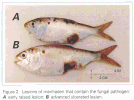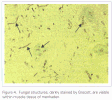 |
|
|
||||
| Chesapeake Bay Program |
U.S. Geological Survey Fact Sheet 114-98
By Vicki Blazer, Scott Phillips, and Edward Pendleton
The increasing incidence of fish-health problems, ranging from small external sores and lesions to large-scale fish kills in the Chesapeake Bay and other Mid-Atlantic estuaries, is of growing concern to natural resource managers and residents of the Chesapeake Bay watershed. Fish kills have been reported in North Carolina since the early 1990's. Reports of skin lesions on fish in the summer and fall of 1996 and 1997 in the Pocomoke River, Maryland and other tributaries of Chesapeake Bay stimulated a great deal of public and scientific interest. These skin lesions ranged from small pinpoint hemorrhages to abrasions to deep ulcers. In addition, there were two fish kills, involving primarily Atlantic menhaden, in the Pocomoke River during August 1997. The fish kills, as well as the variety of fish lesions, have been blamed on the presence of a toxic dinoflagellate, Pfiesteria piscicida, or Pfiesteria-like dinoflagellates. The occurrence of Pfiesteria has been attributed to nutrient enrichment, warm water temperatures, moderate to high salinity, and fish excretions (Burkholder and Glasgow, 1997).
While Pfiesteria has been identified as a potential cause of fish kills in the Chesapeake Bay and other estuaries, there is growing evidence that other pathogens also are causing lesions in fish in the Bay. Skin lesions in fish can be caused by a variety of infectious and noninfectious insults. Lesions commonly are caused by opportunistic pathogens, which infect weakened or stressed hosts. These pathogens, which include bacteria, fungi, viruses, and parasites, may gain entry because of impaired immune or disease resistance factors, or because the natural defense mechanisms of the skin are impaired or breached.
Several State and Federal agencies, including the U.S. Geological Survey (USGS), are currently working to understand the relation between Pfiesteria and other pathogens to fish and human health, and to natural and man-induced factors (such as nutrients and sediment). This information will be used to help formulate management solutions to the problem.
In 1983, the U.S. Environmental Protection Agency began the Chesapeake Bay Program with other Federal Agencies and several States to restore the ecosystem of the Bay and its watershed. The USGS has been an active partner since the formation of this program, and has provided scientific information on the relation between contaminant inputs (nutrients, sediment, and toxins) and the response of water quality and living resources.
In 1996, the USGS Chesapeake Bay Ecosystem Program was initiated to provide scientific information to resource managers on the response of water quality and living resources to changes in nutrient sources. As part of the Ecosystem and other USGS Programs, the USGS Leetown Science Center and the Maryland Cooperative Fish and Wildlife Research Unit began investigations to determine factors contributing to fish lesions in selected tributaries of the Chesapeake Bay. USGS studies include characterizing the type and cause of fish lesions and evaluating overall fish health using a variety of physiological, histological, and immunological techniques. Additionally, researchers at Leetown work with other USGS scientists to document the potential linkages between the occurrence of lesions and water quality, land use, and nutrient sources and transport to the Bay. Some of the locations of different components of USGS studies of fish health and nutrient sources and transport are shown in figure 1.
 |
Figure 1. Location of USGS fish collection, streamflow, and water-quality sampling sites near Pfiesteria outbreaks on Chesapeake Bay tributaries in Maryland and Delaware. |
The USGS and State partners collected menhaden from sites affected by fish kills and river closures from August through October 1997. Menhaden with lesions also were collected in the Wicomico and Pocomoke Rivers in August 1998 (Fig. 1). Ninety-five percent of the menhaden with lesions collected in 1997 and 100 percent collected in 1998 had chronic sores in response to an invasive fungus (Fig. 2).
 |
Figure 2. Lesions of menhaden that contain the fungal pathogen: A early raised lesion; B advanced ulcerated lesion. |
The stained microscopic appearance (Fig. 3A) of most of these lesions is identical to that of lesions observed on fish in other estuarine environments where cutaneous ulcerative syndromes are associated with an invasive fungus called Aphanomyces invadans (Fig. 4). These syndromes include red spot disease (RSD) in Australia, epizootic ulcerative syndrome (EUS) of Asian fishes, and mycotic granulomatosis (MG) in Japan. Outbreaks of EUS and RSD have been correlated with rainfall-runoff events, warm water temperatures, and low levels of dissolved oxygen (less than one milligram per liter).
Previous research activities suggest that the fungal infections seen in menhaden and other estuarine fish in North Carolina are secondary to exposure of the fish to toxins from Pfiesteria (Noga and others, 1996; Burkholder and Glasgow, 1997). But scientific evidence of a relation between these lesions and exposure to toxic dinoflagellates is lacking.
In 1998, a fungus was isolated from lesioned menhaden in the Wicomico and Pocomoke Rivers. By preliminary analyses including growth requirements, growth-temperature curves and appearance in culture these isolates appear to be similar or identical to Aphanomyces invadans (James Lilley, oral commun., 1998, Stirling University, Stirling, Scotland).
Laboratory exposures to Pfiesteria have not resulted in similar lesions. Respiratory distress, neurological dysfunction, and a cloudiness of the skin with acute mortalities were reported in early laboratory studies (Smith and others, 1988; Noga and others, 1993).
Microscopic study of skin shows swelling of cells and the death of skin cells, resulting in deep sores extending through the skin (Noga and others, 1996). This study also examined fish that survived an acute sublethal exposure to Pfiesteria piscicida and then were placed into clean water. One of ten fish developed a fungal infection. This infection, however, appeared typical of fungal organisms growing in necrotic tissue. The fungus did not cause the typical granulomatous response (Fig. 3A) seen in wild fish captured in Bay tributaries.
Burkholder and Glasgow (1997) stated that "the fungi are opportunists; their hyphae generally do not penetrate to the lesion base, suggesting they do not form the lesions; rather, they colonize lesions formed by toxin(s) from Pfiesteria piscicida." This phenomenon was not observed in menhaden collected in the Chesapeake tributaries. In many instances, the fungal organism and surrounding chronic inflammation extended deep into muscle, under intact, normal skin. In a number of menhaden, the fungal organism had actually penetrated to and through visceral organs such as the liver.
 |
Figure 4. Fungal structures, darkly stained by Grocott, are visible within muscle tissue of menhaden. |
The USGS is compiling information on estuarine water quality and the human and landscape factors that may affect fish health, such as road density, population density, forest fragmentation, and patterns of nutrient sources. Additionally, information on land characteristics that influence nutrient transport, such as soil type, riparian zones, extent of drainage ditching, and geology is being compiled and integrated with streamflow and water-quality data being collected in the Pocomoke River Basin.
Resource managers will use the information on nutrient sources and transport to evaluate management practices that are being implemented to reduce nutrients entering the Bay and tributaries. In Maryland, legislation has been passed requiring farmers to adopt plans to control nitrogen runoff by July 2001 and phosphorous runoff by July 2004.
Excess nutrients (phosphorus and nitrogen) in the soil can either run off into streams directly or percolate through the soil to the water table and reach streams as ground-water discharge. Phosphorus tends to bind with sediment particles and is transported primarily with surface water, whereas dissolved nitrogen travels in both surface water and ground water. Ground water in shallow aquifers that discharges to streams is called "base flow."
The USGS has found that the proportion of streamflow contributed by base flow in shallow aquifers of the Coastal Plain ranges from approximately 42 to 74 percent (Bachman and others, 1998). On the basis of existing data, the concentration of nitrate in shallow aquifers underlying the lower Eastern Shore of Maryland generally ranges from less than 0.1 to 35 milligrams per liter. The associated age of most of the water in shallow Coastal Plain aquifers ranges from 0 to 20 years (Focazio and others, 1998). This indicates that, despite recent changes in management practices to control nitrogen, an improvement in surface-water quality may take a number of years to evolve. The USGS is currently collecting additional information to better document the nutrients and associated ground-water residence times in aquifers discharging to surface-water bodies in the Pocomoke River Basin.
Pfiesteria was detected in Maryland waters in 1997 and was believed to be the primary cause of fish kills. Maryland has established criteria to close rivers on the basis of both fish kills, fish lesions, and other factors. Therefore, there is a need for resource managers to understand the causes of both fish kills and lesions. While it is indeed possible that toxic dinoflagellates may play a role in the initiation of fish lesions, other factors also need to be considered. The finding of massive cell death over top of the chronic tissue damage in the muscle of fish from the river closure areas suggests these inflamed lesions were present prior to exposure to Pfiesteria toxin. It is possible that large numbers of migrating menhaden with open skin sores could stimulate the dinoflagellate blooms. Further research is needed to study the development of this fungal disease in menhaden, to understand the underlying stressors that may initiate this and other infections either by skin damage or immunosuppression, and to understand what role toxic dinoflagellates play in these lesions. It is also important to determine the time of year when the menhaden first become infected and to follow the development of these chronic lesions. In addition to the occurrence of lesions, the environmental factors -- nutrients, contaminants, fresh-water flow, and estuarine conditions-contributing to their occurrence must be understood in order to formulate effective management solutions. The USGS continues to work with appropriate State and Federal agencies to address fish health issues in the Chesapeake Bay.
Bachman, L.J., Lindsey, B.D., Brakebill, J.B., and Powars, D.S., 1998, Ground-water discharge and base-flow nitrate loads of nontidal streams, and their relation to a hydrogeomorphic classification of the Chesapeake Bay watershed, Middle Atlantic Coast: U.S. Geological Survey Water-Resources Investigations Report 98-4059, 7l p.
Burkholder, J.M., and Glasgow, H.B., Jr., 1997, Pfiesteria piscicida and other Pfiesteria-like dinoflagellates: Behavior, impacts, and environmental controls: Limnol. Oceanogra. V. 42, p. 1052-1075.
Focazio, M.J., Plummer, L.N., Bohlke, J.K., Busenberg, Eurybiades, Bachman, L.J., and Powars, D.S., 1998, Preliminary estimates of residence times and apparent ages of ground water in the Chesapeake Bay watershed, and water-quality data from a survey of springs: U.S. Geological Survey Water-Resources Investigations Report 97-4225, 75 p.
Noga, E.J., Smith, S.A., Burkholder, J.M., Hobbs, C., and Bullis, R.A., 1993, A new ichthyotoxic dinoflagellate: cause of acute mortality in aquarium fishes: Vet Rec., V. 133, p. 96-97.
Noga, E.J., Khoo, J.B., Stevens, Z. F., and Burkholder, J.M., 1996, Novel toxic dinoflagellate causes epidemic disease in estuarine fish: Marine Pollution Bulletin V. 32, p. 219-224.
Smith, S.A., Noga, E.J., and Bullis, R.A., 1988, Mortality in Tilapia aurea due to a toxic dinoflagellate bloom: Abstract in Proceedings of the Third International Colloq. Pathologic Marine Aquaculture: Gloucester Point, Virginia, p. 167-168.
For further information contact:
Chesapeake Bay Program Coordinator
U.S. Geological Survey
8987 Yellow Brick Road
Baltimore, Maryland 21237
or visit the USGS Chesapeake Bay Homepage:
http://chesapeake.usgs.gov/chesbay/
| AccessibilityFOIAPrivacyPolicies and Notices | |
 |
|